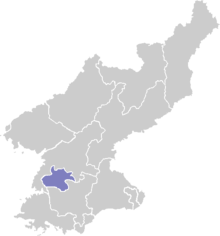Pyongyang
Pyongyang (US: /ˌpjɒŋˈjæŋ/, UK: /ˌpjʌŋˈjɑːŋ/,[6] Korean: [pʰjʌŋ.jaŋ]) is the capital and largest city of North Korea. Pyongyang is located on the Taedong River about 109 kilometers (68 mi) upstream from its mouth on the Yellow Sea. According to the 2008 population census, it has a population of 3,255,288.[7] Pyongyang is a directly-administered city (직할시; 直轄市; chikhalsi) with equal status to North Korean provinces.
Pyongyang 평양시 平壤市 | |
|---|---|
| Pyongyang Directly Governed City 평양직할시 平壤直轄市 | |
| transcription(s) | |
| • Chosŏn'gŭl | 평양직할시 |
| • Hancha | 平壤直轄市 |
| • McCune–Reischauer | P'yŏngyang Chikhalsi |
| • Revised Romanization | Pyeongyang Jikhalsi |
| • Official North Korean variant | Phyŏngyang Jikhalsi |
 Clockwise from top left: Pyongyang skyline and the Taedong River; Juche Tower; Arch of Triumph; Tomb of King Tongmyeong; Puhŭng Station in the Pyongyang Metro; Arch of Reunification; and Kumsusan Palace of the Sun | |
| Nickname(s): | |

Location of Pyongyang in North Korea | |
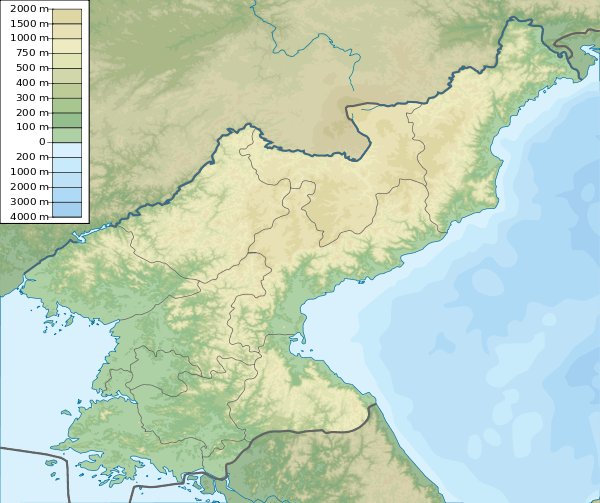 Pyongyang Location of Pyongyang in North Korea 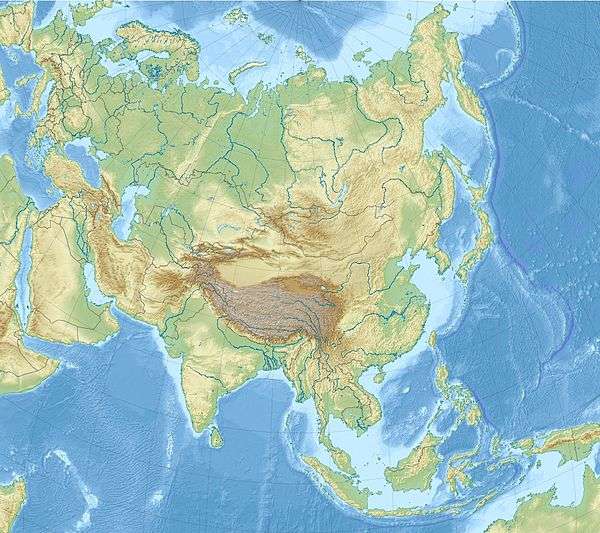 Pyongyang Pyongyang (Asia) | |
| Coordinates: 39°1′10″N 125°44′17″E | |
| Country | North Korea |
| Province | Pyongan |
| Districts | |
| Government | |
| • Chairman of Pyongyang People's Committee | Cha Hui-rim[2] |
| • Secretary of the Workers' Party of Korea Pyongyang City Committee | Kim Yong-hwan[3] |
| Area | |
| • Total | 2,000 km2 (800 sq mi) |
| Population (2016) | |
| • Total | 2,870,000[5] |
| Time zone | UTC+9 (Pyongyang Time) |
Pyongyang is considered one of the oldest cities in Korea.[8] It was the capital of two ancient Korean kingdoms, including Gojoseon and Goguryeo, and served as the secondary capital of Goryeo. Much of the city was destroyed during the First Sino-Japanese War, but it was revived under Japanese rule and became an industrial center. Following the establishment of North Korea in 1948, Pyongyang became its de facto capital. The city was again devastated during the Korean War, but was quickly rebuilt after the war with Soviet assistance.
Pyongyang is the political, industrial and transport center of North Korea. It is home to North Korea's major government institutions, as well as the ruling Workers' Party of Korea.
Names
The city's other historic names include Kisong, Hwangsong, Rakrang, Sŏgyong, Sodo, Hogyong, Changan, and Heijō[9][10] (during Japanese rule in Korea). There are several variants.[lower-alpha 1] During the early 20th century, Pyongyang came to be known among missionaries as being the "Jerusalem of the East", due to its historical status as a stronghold of Christianity, namely Protestantism, especially during the Pyongyang revival of 1907.[22][23]
After Kim Il-sung's death in 1994, some members of Kim Jong-il's faction proposed changing the name of Pyongyang to "Kim Il-sung City" (Korean: 김일성시; Hanja: 金日成市), but others suggested that North Korea should begin calling Seoul "Kim Il-sung City" instead and grant Pyongyang the moniker "Kim Jong-il City", and in the end neither proposal was implemented.[24]
Prehistory
In 1955, archaeologists excavated evidence of prehistoric occupation in a large ancient village in the Pyongyang area, called Kŭmtan-ni, dating to the Jeulmun and Mumun pottery periods.[25] North Koreans associate Pyongyang with the mythological city of "Asadal" (Korean: 아사달; Hanja: 阿斯達), or Wanggeom-seong (Korean: 왕검성; Hanja: 王儉城), the first second millennium BC capital of Gojoseon ("Old Joseon") according to Korean historiographies beginning with the 13th-century Samgungnyusa.
Historians deny this claim because earlier Chinese historiographical works such as the Guanzi, Classic of Mountains and Seas, Records of the Grand Historian, and Records of the Three Kingdoms, mention a much later "Joseon". The connection between the two therefore may have been asserted by North Korea for the use of propaganda. Nevertheless, Pyongyang became a major city in old Joseon.
History

Korean mythology asserts that Pyongyang was founded in 1122 BC on the site of the capital of the legendary king Dangun.[8] Wanggeom-seong, which was in the location of Pyongyang, became the capital of Gojoseon from 194 to 108 BC. It fell in the Han conquest of Gojoseon in 108 BC. Emperor Wu of Han ordered four commanderies be set up, with Lelang Commandery in the center and its capital established as "樂浪" (Old Chinese: *[r]ˤawk*[r]ˤaŋ,[26] Standard Chinese: pinyin: Lèlàng, Korean: 낙랑; Hanja: 樂浪). Several archaeological findings from the later, Eastern Han (20–220 AD) period in the Pyeongyang area seems to suggest that Han forces later launched brief incursions around these parts.
The area around the city was called Nanglang during the early Three Kingdoms period. As the capital of Nanglang (Korean: 낙랑국; Hanja: 樂浪國),[lower-alpha 2] Pyeongyang remained an important commercial and cultural outpost after the Lelang Commandery was destroyed by an expanding Goguryeo in 313.
Goguryeo moved its capital there in 427. According to Christopher Beckwith, Pyongyang is the Sino-Korean reading of the name they gave it in their language: Piarna, or "level land".[27]
In 668, Pyongyang became the capital of the Protectorate General to Pacify the East established by the Tang dynasty of China. However, by 676, it was taken by Silla, but left on the border between Silla and Balhae. Pyongyang was left abandoned during the Later Silla period, until it was recovered by Wang Geon and decreed as the Western Capital of Goryeo. During the Joseon period, it became the provincial capital of Pyeongan Province.
During the Japanese invasions of Korea (1592–98), Pyongyang was captured by the Japanese and held until they were defeated in the Siege of Pyongyang.[8] Later in the 17th century, it became temporarily occupied during the Qing invasion of Joseon until peace arrangements were made between Korea and Qing China. While the invasions made Koreans suspicious of foreigners, the influence of Christianity began to grow after the country opened itself up to foreigners in the 16th century. Pyongyang became the base of Christian expansion in Korea, and by 1880 it had more than 100 churches and more Protestant missionaries than any other Asian city.[8]
In 1890, the city had 40,000 inhabitants.[28] It was the site of the Battle of Pyongyang during the First Sino-Japanese War, which led to the destruction and depopulation of much of the city. It was the provincial capital of South Pyeongan Province beginning in 1896. Under Japanese colonial rule, the city became an industrial center, called Heijō (with the same Chinese characters 平壤 but read as へいじょう) in Japanese.
In July 1931 the city experienced anti-Chinese riots as a result of the Wanpaoshan Incident and the sensationalized media reports about it which appeared in Imperial Japanese and Korean newspapers.[29]
By 1938, Pyongyang had a population of 235,000.[28]
After 1945
.jpg)
On 25 August 1945, the Soviet 25th Army entered Pyongyang and it became the temporary capital of the Provisional People's Committee for North Korea. A People's Committee was already established there, led by veteran Christian nationalist Cho Man-sik.[30] Pyongyang became the de facto capital of North Korea upon its establishment in 1948. At the time, the Pyongyang government aimed to recapture Korea's official capital, Seoul. Pyongyang was again severely damaged in the Korean War, during which it was briefly occupied by South Korean forces from 19 October to 6 December 1950. In 1952, it was the target of the largest aerial raid of the entire war, involving 1,400 UN aircraft.
Already during the war, plans were made to reconstruct the city. On 27 July 1953 – the day the armistice between North Korea and South Korea was signed – The Pyongyang Review wrote: "While streets were in flames, an exhibition showing the general plan of restoration of Pyongyang was held at the Moranbong Underground Theater", the air raid shelter of the government under Moranbong. "On the way of victory... fireworks which streamed high into the night sky of the capital in a gun salute briefly illuminated the construction plan of the city which would rise soon with a new look".[31] After the war, the city was quickly rebuilt with assistance from the Soviet Union, and many buildings were built in the style of Stalinist architecture. The plans for the modern city of Pyongyang were first displayed for public viewing in a theatre building. Kim Jung-hee, one of the founding members of the Korean Architects Alliance, who has studied architecture in prewar Japan was appointed by Kim Il Sung to build the city masterplan, Moscow Architecture Institute, designed the “Pyongyang City Reconstruction and Construction Comprehensive Plan” in 1951, and was officially adopted in 1953. The transformation into a modern, propaganda-designed city called Stalin style architecture with a Korean-style arrangement (and other modernist architecture that was said to have been greatly influenced by Brazilian architect Oscar Niemeyer) began.[32] and in the 1972 Constitution it was officially declared as the capital.
In 2001, North Korean authorities began a long-term modernisation programme. The Ministry of Capital City Construction Development was included in the Cabinet in that year. In 2006, Kim Jong-il's brother-in-law Jang Song-thaek took charge of the ministry.
Geography
Pyongyang is in the west-central part of North Korea; the city lies on a flat plain about 50 kilometres (31 mi) east of the Korea Bay, an arm of the Yellow Sea. The Taedong River flows southwestward through the city toward the Korea Bay. The Pyongyang plain, where the city is situated, is one of the two large plains on the Western coast of the Korean peninsula, the other being the Chaeryong plain. Both have an area of approximately 500 square kilometers.[33]
Climate
Pyongyang has a hot-summer humid continental climate (Köppen: Dwa), featuring warm to hot, humid summers and cold, dry winters.[34][35] Cold, dry winds can blow from Siberia in winter, making conditions very cold; the low temperature is usually below freezing between November and early March, although the average daytime high is at least a few degrees above freezing in every month except January. The winter is generally much drier than summer, with snow falling for 37 days on average.
The transition from the cold, dry winter to the warm, wet summer occurs rather quickly between April and early May, and there is a similarly abrupt return to winter conditions in late October and November. Summers are generally hot and humid, with the East Asian monsoon taking place from June until August; these are also the hottest months, with average temperatures of 21 to 25 °C (70 to 77 °F), and daytime highs often above 30 °C (86 °F).
| Climate data for Pyongyang, 1981–2010 normals, extremes 1961–present | |||||||||||||
|---|---|---|---|---|---|---|---|---|---|---|---|---|---|
| Month | Jan | Feb | Mar | Apr | May | Jun | Jul | Aug | Sep | Oct | Nov | Dec | Year |
| Record high °C (°F) | 10.0 (50.0) |
16.0 (60.8) |
21.4 (70.5) |
28.4 (83.1) |
33.9 (93.0) |
35.8 (96.4) |
35.9 (96.6) |
37.8 (100.0) |
32.2 (90.0) |
28.9 (84.0) |
23.2 (73.8) |
15.0 (59.0) |
37.8 (100.0) |
| Average high °C (°F) | −0.9 (30.4) |
2.9 (37.2) |
9.1 (48.4) |
17.5 (63.5) |
23.0 (73.4) |
27.1 (80.8) |
28.6 (83.5) |
29.2 (84.6) |
25.1 (77.2) |
18.5 (65.3) |
9.5 (49.1) |
1.8 (35.2) |
16.0 (60.8) |
| Daily mean °C (°F) | −6.0 (21.2) |
−2.4 (27.7) |
3.5 (38.3) |
11.0 (51.8) |
16.9 (62.4) |
21.5 (70.7) |
24.3 (75.7) |
24.6 (76.3) |
19.6 (67.3) |
12.5 (54.5) |
4.4 (39.9) |
−2.8 (27.0) |
10.6 (51.1) |
| Average low °C (°F) | −10.3 (13.5) |
−6.9 (19.6) |
−1.3 (29.7) |
5.6 (42.1) |
11.7 (53.1) |
17.0 (62.6) |
21.0 (69.8) |
21.1 (70.0) |
15.1 (59.2) |
7.6 (45.7) |
0.3 (32.5) |
−6.6 (20.1) |
6.2 (43.2) |
| Record low °C (°F) | −26.5 (−15.7) |
−23.4 (−10.1) |
−16.1 (3.0) |
−6.1 (21.0) |
2.2 (36.0) |
7.0 (44.6) |
12.0 (53.6) |
12.8 (55.0) |
3.6 (38.5) |
−6.0 (21.2) |
−14.0 (6.8) |
−22.8 (−9.0) |
−26.5 (−15.7) |
| Average precipitation mm (inches) | 11 (0.4) |
14 (0.6) |
27 (1.1) |
47 (1.9) |
76 (3.0) |
85 (3.3) |
268 (10.6) |
202 (8.0) |
111 (4.4) |
40 (1.6) |
37 (1.5) |
16 (0.6) |
933 (36.7) |
| Average rainy days | 2 | 3 | 7 | 9 | 12 | 13 | 19 | 14 | 10 | 9 | 9 | 5 | 146 |
| Average snowy days | 8 | 6 | 3 | 0.3 | 0 | 0 | 0 | 0 | 0 | 0.2 | 3 | 7 | 28 |
| Average relative humidity (%) | 70 | 66 | 63 | 61 | 66 | 72 | 82 | 81 | 77 | 73 | 72 | 71 | 71 |
| Mean monthly sunshine hours | 184 | 197 | 231 | 237 | 263 | 229 | 181 | 204 | 222 | 214 | 165 | 165 | 2,492 |
| Average ultraviolet index | 2 | 3 | 4 | 6 | 7 | 8 | 9 | 9 | 7 | 4 | 2 | 1 | 5 |
| Source: Pogodaiklimat.ru[36], Deutscher Wetterdienst (sun, 1961–1990)[37] and Weather Atlas[38] | |||||||||||||
Politics

Major government and other public offices are located in Pyongyang, which is constitutionally designated as the country's capital.[39] The seat of the Workers' Party Central Committee and the Pyongyang People's Committee are located in Haebangsan-dong, Chung-guyok. The Cabinet of North Korea is located in Jongro-dong, Chung-guyok.
Pyongyang is also the seat of all major North Korean security institutions. The largest of them, the Ministry of People's Security, has 130,000 employees working in 12 bureaus. These oversee activities including: police services, security of party officials, classified documents, census, civil registrations, large-scale public construction, traffic control, fire safety, civil defense, public health and customs.[40] Another significant structure based in the city is the State Security Department, whose 30,000 personnel manage intelligence, political prison systems, military industrial security and entry and exit management.[41]
The politics and management of the city is dominated by the Workers' Party of Korea, as they are in the national level. The city is managed by the Pyongyang Party Committee of the Workers' Party of Korea and its chairman is the de facto mayor. The supreme standing state organ is the Pyongyang People's Committee, responsible for everyday events in support of the city. This includes following local Party guidance as channeled through the Pyongyang Party Committee, the distribution of resources prioritised to Pyongyang, and providing support to KWP and internal security agency personnel and families.
Administrative status and divisions
P'yŏngyang is divided into 18 wards (ku- or guyŏk) (the city proper) and 2 counties (kun or gun).[42]
- Chung-guyok (중구역; 中區域)
- Pyongchon-guyok (평천구역; 平川區域)
- Potonggang-guyok (보통강구역; 普通江區域)
- Moranbong-guyok (모란봉구역; 牡丹峰區域)
- Sŏsŏng-guyŏk (서성구역; 西城區域)
- Songyo-guyok (선교구역; 船橋區域)
- Tongdaewŏn-guyŏk (동대원구역; 東大院區域)
- Taedonggang-guyŏk (대동강구역; 大同江區域)
- Sadong-guyŏk (사동구역; 寺洞區域)
- Taesong-guyok (대성구역; 大城區域)
- Mangyongdae-guyok (만경대구역; 萬景台區域)
- Hyongjesan-guyok (형제산구역; 兄弟山區域)
- Ryongsong-guyok (룡성구역; 龍城區域)
- Samsok-guyok (삼석구역; 三石區域)
- Ryokpo-guyok (력포구역; 力浦區域)
- Rakrang-guyok (락랑구역; 樂浪區域)
- Sunan-guyŏk (순안구역; 順安區域)
- Unjong-guyok (은정구역; 恩情區域)
- Kangdong County (강동군; 江東郡)
- Kangnam County (강남군; 江南郡)
Foreign media reports in 2010 stated that Kangnam-gun, Chunghwa-gun, Sangwŏn-gun, and Sŭngho-guyŏk had been transferred to the administration of neighboring North Hwanghae province.[43] However, Kangnam-gun was returned to Pyongyang in 2011.[44]
Cityscape
.jpg)
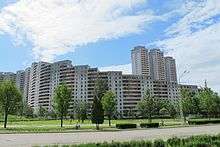
After being destroyed during the Korean War, Pyongyang was entirely rebuilt according to Kim Il-sung's vision, which was to create a capital that would boost morale in the post-war years.[45] The result was a city with wide, tree-lined boulevards and public buildings with terraced landscaping, mosaics and decorated ceilings.[46] Its Russian-style architecture makes it reminiscent of a Siberian city during winter snowfall, although edifices of traditional Korean design somewhat soften this perception. In summer, it is notable for its rivers, willow trees, flowers and parkland.[46]
The streets are laid out in a north-south, east-west grid, giving the city an orderly appearance.[46] North Korean designers applied the Swedish experience of self-sufficient urban neighbourhoods throughout the entire country, and Pyongyang is no exception. Its inhabitants are mostly divided into administrative units of 5,000 to 6,000 people (dong). These units all have similar sets of amenities including a food store, a barber shop, a tailor, a public bathhouse, a post office, a clinic, a library and others. Many residents occupy high-rise apartment buildings.[47] One of Kim Il-sung's priorities while designing Pyongyang was to limit the population. Authorities maintain a restrictive regime of movement into the city, making it atypical of East Asia as it is silent, uncrowded and spacious.[48]
Structures in Pyongyang are divided into three major architectural categories: monuments, buildings with traditional Korean motifs and high-rises.[49] Some of North Korea's most recognisable landmarks are monuments, like the Juche Tower, the Arch of Triumph and the Mansu Hill Grand Monument. The first of them is a 170-meter granite spire symbolizing the Juche ideology. It was completed in 1982 and contains 25,550 granite blocks, one for each day of Kim Il-sung's life up to that point.[49] The most prominent building on Pyongyang's skyline is Ryugyong Hotel,[49] the seventh highest building in the world terms of floor count, the tallest unoccupied building in the world,[50] and one of the tallest hotels in the world. It has yet to open.[51][52]
Pyongyang has a rapidly evolving skyline, dominated by high-rise apartment buildings. A construction boom began with the Changjon Street Apartment Complex, which was completed in 2012.[53] Construction of the complex began after late leader Kim Jong-il described Changjon Street as "pitiful".[54] Other housing complexes are being upgraded as well, but most are still poorly insulated, and lacking elevators and central heating.[55] An urban renewal program continued under Kim Jong-un's leadership, with the old apartments of the 1970s and '80s replaced by taller high rise buildings and leisure parks like the Kaesong Youth Park, as well as renovations of older buildings.[56] In 2018, the city was described as unrecognizable compared to five years before.[57]
Landmarks
Notable landmarks in the city include:
- the Ryugyong Hotel
- the Kumsusan Palace of the Sun
- the Arch of Triumph (heavily inspired by, but larger than, Paris's Arc de Triomphe)
- the birthplace of Kim Il-sung at Mangyongdae Hill at the city outskirts
- Juche Tower
- two large stadiums:
- the Mansu Hill complex, including the Korean Revolution Museum
- Kim Il-sung Square
- Yanggakdo International Hotel
Pyongyang TV Tower is a minor landmark. Other visitor attractions include the Korea Central Zoo. The Arch of Reunification has a map of a united Korea supported by two concrete Korean women dressed in traditional dress straddling the Reunification Highway, which stretches from Pyongyang to the Korean Demilitarized Zone (DMZ).
- Monuments and sights of Pyongyang
 Juche Tower Monument to the philosophy of Juche (self-reliance)
Juche Tower Monument to the philosophy of Juche (self-reliance)
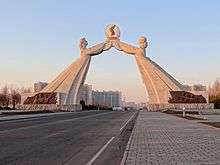 Arch of Reunification, a monument to the goal of a reunified Korea
Arch of Reunification, a monument to the goal of a reunified Korea
 Rungrado May Day Stadium
Rungrado May Day Stadium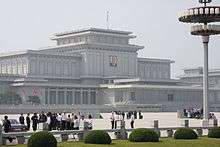
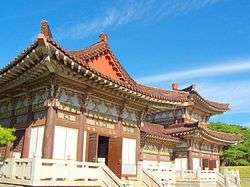 Tomb of King Tongmyeong
Tomb of King Tongmyeong.jpg)

Culture
Cuisine
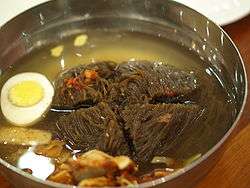
Pyongyang served as the provincial capital of South Pyongan Province until 1946,[58] and Pyongyang cuisine shares the general culinary tradition of the Pyongan province. The most famous local food is Pyongyang raengmyŏn, or also called mul raengmyŏn or just simply raengmyŏn. Raengmyŏn literally means "cold noodles", while the affix mul refers to water because the dish is served in a cold broth. Raengmyŏn consists of thin and chewy buckwheat noodles in a cold meat-broth with dongchimi (watery kimchi) and topped with a slice of sweet Korean pear.
Pyongyang raengmyŏn was originally eaten in homes built with ondol (traditional underfloor heating) during the cold winter, so it is also called "Pyongyang deoldeori" (shivering in Pyongyang). Pyongyang locals sometimes enjoyed it as a haejangguk, which is any type of food eaten as a hangover-cure, usually a warm soup.[59]
Another representative Pyongyang dish, Taedonggang sungeoguk, translates as "trout soup from the Taedong River". The soup features trout (abundant in the Taedong River) along with black peppercorns and salt.[60] Traditionally, it has been served to guests visiting Pyongyang. Therefore, there is a common saying, "How good was the trout soup?", which is used to greet people returning from Pyongyang. Another local specialty, Pyongyang onban (literally "warm rice of Pyongyang") comprises freshly cooked rice topped with sliced mushrooms, chicken, and a couple of bindaetteok (pancakes made from ground mung beans and vegetables).[59]
Social life
In 2018, there were many high quality restaurants in Pyongyang with Korean and international food, and imported alcoholic beverages.[61] Famous restaurants include Okryu-gwan and Ch'ongryugwan.[62] Some street foods exist in Pyongyang, where vendors operate food stalls.[63] Foreign foods like hamburgers, fries, pizza, and coffee are easily found.[61] There is an active nightlife with late-night restaurants and karaoke.[61]
The city has water parks, amusement parks, skating rinks, health clubs, a shooting range, and a dolphinarium.[56]
Sports
Pyongyang has a number of sports clubs, including the April 25 Sports Club and the Pyongyang City Sports Club.[64] The most popular sport in Pyongyang is football.
Economy
.jpg)
Pyongyang is North Korea's industrial center.[8] Thanks to the abundance of natural resources like coal, iron and limestone, as well as good land and water transport systems, it was the first industrial city to emerge in North Korea after the Korean War. Light and heavy industries are both present and have developed in parallel. Heavy manufactures include cement, industrial ceramics, munitions and weapons, but mechanical engineering remains the core industry. Light industries in Pyongyang and its vicinity include textiles, footwear and food, among others. Special emphasis is put on the production and supply of fresh produce and subsidiary crops in farms on the city's outskirts. Other crops include rice, sweetcorn and soybeans. Pyongyang aims to achieve self-sufficiency in meat production. High-density facilities raise pigs, chicken and other livestock.[8]
The city still experiences frequent shortages of electricity.[65] To solve this problem, two power stations – Huichon Power Stations 1 and 2 – were built in Chagang Province and supply the city through direct transmission lines. A second phase of the power expansion project was launched in January 2013, consisting of a series of small dams along the Chongchon River. The first two power stations have a maximum generating capacity of 300 megawatts (MW), while the 10 dams to be built under second phase are expected to generate about 120 MW.[65] In addition, the city has several existing or planned thermal power stations. These include Pyongyang TPS with a capacity of 500 MW, East Pyongyang TPS with a capacity of 50 MW, and Kangdong TPS which is under construction.[66]
Retail
.jpg)
Pyongyang is home to several large department stores including the Pothonggang Department Store, Pyongyang Department Store No. 1, Pyongyang Department Store No. 2, Kwangbok Department Store, Ragwon Department Store, Pyongyang Station Department Store, and the Pyongyang Children's Department Store.[67]
The city also has Hwanggumbol Shop, a chain of state-owned convenience stores supplying goods at prices cheaper than those in the jangmadang markets. Hwanggumbol Shops are specifically designed to control North Korea's expanding markets by attracting consumers and guaranteeing the circulation of money in government-operated stores.[68]
Transportation
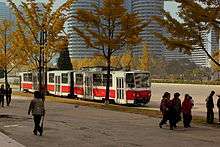
Pyongyang is also the main transport hub of the country: it has a network of roads, railways and air routes which link it to both foreign and domestic destinations. It is the starting point of inter-regional highways reaching Nampo, Wonsan and Kaesong.[8] Pyongyang railway station serves the main railway lines, including the Pyongui Line and the Pyongbu Line. Regular international rail services to Beijing, the Chinese border city of Dandong and Moscow are also available.
A rail journey to Beijing takes about 25 hours and 25 minutes (K27 from Beijing/K28 from Pyongyang, on Mondays, Wednesdays, Thursdays and Saturdays); a journey to Dandong takes about 6 hours (daily); a journey to Moscow takes six days. The city also connects to the Eurasian Land Bridge via the Trans-Siberian Railway. A high-speed rail link to Wonsan is planned.[69]
.jpg)
The Metro, tram and trolleybus systems are used mainly by commuters as a primary means of urban transportation.[8] Cycle lanes were introduced on main thoroughfares in July 2015.[70] There are relatively few cars in the city. Cars are a symbol of status in the country due to their scarcity as a result of restrictions on import because of international sanctions and domestic regulations.[71] Some roads are also reported to be in poor condition.[72] However, by 2018, Pyongyang had begun to experience traffic jams.[61]
State-owned Air Koryo has scheduled international flights from Pyongyang Sunan International Airport to Beijing (PEK), Shenyang (SHE), Vladivostok (VVO), Shanghai (PVG) and Dandong.[73] The only domestic destinations are Hamhung, Wonsan, Chongjin, Hyesan and Samjiyon. Since 31 March 2008, Air China launched a regular service between Beijing and Pyongyang,[74] although Air China's flights are often canceled due to lack of passengers.[75]
Education and science
Kim Il-sung University, North Korea's oldest university, was established in 1946.[8] It has seven colleges, 14 faculties and 16 other institutes, graduate schools and university units.[76] These include the primary medical education and health personnel training unit, the medical college; a physics faculty which covers a range of studies including theoretical physics, optical science, geophysics and astrophysics;[77] an atomic energy institute and a human evolution research office which studies human evolution through a Juche point of view. Kim Il-sung University also has its own publishing house, sports club (Ryongnamsan Sports Club),[78] revolutionary museum, nature museum, libraries, a gym, indoor swimming pool and educator apartment houses. Its two main buildings were completed in 1965 (Building 1) and 1972 (Building 2). A third building on campus is planned.[79]
Other higher education establishments include Kim Chaek University of Technology, Pyongyang University of Music and Dance and Pyongyang University of Foreign Studies. Pyongyang University of Science and Technology (PUST) is the country's first private university where most of the lecturers are American and courses are carried out in English.[80][81] A science and technology hall is under construction on Ssuk Islet. Its stated purpose is to contribute to the "informatization of educational resources" by centralizing teaching materials, compulsory literature and experimental data for state-level use in a digital format.[82]
Sosong-guyok hosts a 20 MeV cyclotron called MGC-20. The initial project was approved by the International Atomic Energy Agency (IAEA) in 1983 and funded by the IAEA, the United States and the North Korean government. The cyclotron was ordered from the Soviet Union in 1985 and constructed between 1987 and 1990. It is used for student training, production of medical isotopes for nuclear medicine as well as studies in biology, chemistry and physics.[83]
Healthcare
Medical centers include the Red Cross Hospital, the First People's Hospital which is located near Moran Hill and was the first hospital to be built in North Korea after the liberation of Korea in 1945,[84] the Second People's Hospital, Ponghwa Recuperative Center (also known as Bonghwa Clinic or Presidential Clinic) located in Sokam-dong, Potonggang-guyok, 1.5 km (0.93 mi) northwest of Kim Il-sung Square,[85] Pyongyang Medical School Hospital, Namsan Treatment Center which is adjacent[86] Pyongyang's Maternity Hospital, Taesongsan General Hospital,[87] Kim Man-yoo Hospital, Staff Treatment Center and Okryu Children's Hospital.
Twin towns
Pyongyang is twinned with:
See also
Notes
References
Citations
- Funabashi, Yoichi (2007). The Peninsula Question: A Chronicle of the Second Northern Korean Nuclear Crisis. Washington, DC: Brookings Institution Press. p. 50. ISBN 978-0-8157-3010-1.
- "Pyongyang Republic, Robert Collins p. 54" (PDF). Hrnk.org.
- “김정은 '최고권력' 조직지도부장 해임 파격…기강잡기 칼 빼들다”. 《연합뉴스》. 2020년 3월 1일. 2020년 3월 1일에 확인함.
- Nick Heath-Brown (ed.), The Statesman's Yearbook 2016: The Politics, Cultures and Economies of the World, p. 720
- "北 작년 평양 인구 287만명…50만명 이상 도시 3개"
- Wells, John C. (2008). Longman Pronunciation Dictionary (3rd ed.). Longman. ISBN 978-1-40588118-0.
- D P R Korea, 2008 Population Census, National Report (PDF file)] Archived 25 March 2009 at the Wayback Machine Retrieved on 17 February 2018.
- "Pyongyang". Encyclopædia Britannica Online. Retrieved 19 April 2015.
- "Wayback Machine". 11 May 2018. Archived from the original on 11 May 2018. Retrieved 30 September 2018.
- ("Heijō: North Korea". Retrieved 26 June 2013.
- "Heijō-fu: North Korea". Retrieved 26 June 2013.)
- "Heizyō: North Korea". Retrieved 26 June 2013.
- "Heizyō Hu: North Korea". Retrieved 26 June 2013.
- "Hpyeng-yang: North Korea". Retrieved 26 June 2013.
- "P-hjöng-jang: North Korea". Retrieved 26 June 2013.
- "Phyeng-yang: North Korea". Retrieved 26 June 2013.
- "Phyong-yang: North Korea". Retrieved 26 June 2013.
- "Pienyang: North Korea". Retrieved 26 June 2013.
- "Pingyang: North Korea". Retrieved 26 June 2013.
- "Pyengyang: North Korea". Retrieved 26 June 2013.
- EB (1878), p. 390.
- Lankov, Andrei (16 March 2005). "North Korea's missionary position". Asia Times Online. Retrieved 25 January 2013.
By the early 1940s Pyongyang was by far the most Protestant of all major cities of Korea, with some 25–30% of its adult population being church-going Christians. In missionary circles this earned the city the nickname "Jerusalem of the East".
- Caryl, Christian (15 September 2007). "Prayer in Pyongyang". The Daily Beast. The Newsweek/Daily Beast Co. Archived from the original on 23 May 2012. Retrieved 25 January 2013.
It's hard to say how many covert Christians the North has; estimates range from the low tens of thousands to 100,000. Christianity came to the peninsula in the late 19th century. Pyongyang, in fact, was once known as the 'Jerusalem of the East.'
- "Pyongyang was to become 'Kim Il Sung City'; The followers of Kim Jong Il suggested the idea". Daily NK. 21 February 2005.
- National Research Institute of Cultural Heritage. 2001. Geumtan-ri. Hanguk Gogohak Sajeon [Dictionary of Korean Archaeology], pp. 148–149. NRICH, Seoul. ISBN 89-5508-025-5
- Baxter, William H.; Sagart, Laurent. "Baxter-Sagart Old Chinese reconstruction (Version 1.00)". Archived from the original on 14 August 2011. Retrieved 20 May 2012.
- Beckwith, Christopher I. (2009). Empires of the Silk Road: A History of Central Eurasia from the Bronze Age to the Present. Princeton University Press. p. 104. ISBN 978-0-691-13589-2.
- Lahmeyer, Jan, "North Korea – Urban Population", Populstat, University of Utrecht
- Memorandum (Institute of Pacific Relations, American Council), Vol. 2, No. 5 (16 Mar 1933), pp. 1–3
- Buzo, Adrian (2002). The Making of Modern Korea. London: Routledge. pp. 54–57. ISBN 0-415-23749-1.
- Schinz, Alfred; Eckart, Dege (1990), "Pyongyang-Ancient and Modern – the Capital of North Korea", GeoJournal, 22 (1): 25, doi:10.1007/BF02428536
- 金聖甫、李信澈『写真と絵で見る北朝鮮現代史』監修:李泳采、韓興鉄訳、コモンズ、東京・新宿(原著2010年12月1日)。ISBN 978-4861870750。2018年4月30日閲覧。
- Country Study 2009, p. 63.
- Muller, M. J. (6 December 2012). Selected climatic data for a global set of standard stations for vegetation science. Springer Science & Business Media. ISBN 978-94-009-8040-2.
- "Pyongyang, North Korea Köppen Climate Classification (Weatherbase)". Weatherbase. Retrieved 24 March 2020.
- "Climate Pyongyang". Pogoda.ru.net. Retrieved 16 May 2019.
- "PYONGYANG SUN 1961–1990". DWD. Retrieved 16 May 2019.
- d.o.o, Yu Media Group. "Pyongyang, North Korea - Detailed climate information and monthly weather forecast". Weather Atlas. Retrieved 9 July 2019.
- Country Study 2009, p. 196.
- Country Study 2009, pp. 276–277.
- Country Study 2009, p. 277.
- "행정구역현황 (Haengjeong Guyeok Hyeonhwang)". NK Chosun. Archived from the original on 9 January 2006. Retrieved 10 January 2006. Also Administrative divisions of North Korea Archived 18 October 2004 at the Wayback Machine (used as reference for hanja)
- "Pyongyang now more than one-third smaller; food shortage issues suspected", Asahi Shimbun, 17 July 2010, retrieved 19 July 2010
- "Kangnam moved into Pyongyang".
- Country Study 2009, p. 91,93–94.
- Country Study 2009, p. 91.
- Country Study 2009, p. 97.
- Country Study 2009, p. 91-92.
- "Architecture and City Planning". Library of Congress. Retrieved 24 April 2015.
- Glenday, Craig (2013). Guinness World Records 2014. p. 144. ISBN 978-1-908843-15-9.
- Staff (15 October 2009). "Will 'Hotel of Doom' ever be finished?". BBC News. BBC. Retrieved 24 April 2015.
- Yoon, Sangwon (1 November 2012). "Kempinski to Operate World's Tallest Hotel in North Korea". Bloomberg L.P. Retrieved 24 April 2015.
- Gray, Nolan (16 October 2018). "The Improbable High-Rises of Pyongyang, North Korea". CityLab. Retrieved 19 October 2018.
- Lee, Seok Young (25 August 2011). ""Pitiful" Changjeon Street the Top Priority". Daily NK. Retrieved 30 August 2011.
- "Pyongyang glitters but most of NKorea still dark". Yahoo News. 29 April 2013. Retrieved 24 April 2015.
- Makinen, Julie (20 May 2016). "North Korea is building something other than nukes: architecture with some zing". Los Angeles Times.
- Salmon, Andrew (4 December 2018). "Going native in the Hermit Kingdom". Asia Times.
- 평양시 平壤市 [Pyongyang] (in Korean). Nate/Encyclopedia of Korean Culture. Archived from the original on 10 June 2011.
- 닮은 듯 색다른 매력을 간직한 북한의 음식 문화 (in Korean). Korea Knowledge Portal. 19 June 2009. Archived from the original on 9 October 2011.
- Ju, Wan-jung (주완중) (12 June 2000). '오마니의 맛' 관심 [Attention to "Mother's taste"]. The Chosun Ilbo (in Korean).
- Salmon, Andrew (4 December 2018). "Going native in the Hermit Kingdom". Asia Times.
- Lankov, Andrei (2007), North of the DMZ: Essays on daily life in North Korea, McFarland, pp. 90–91, ISBN 978-0-7864-2839-7
- Pearson, James; Yeom, Seung-Woo. "Fake meat and free markets ease North Koreans' hunger". Reuters. Retrieved 30 September 2018.
- "The Sights and Sounds of Domestic Football in North Korea". Footy Fair. August 2015. Retrieved 18 January 2018.
- "Ten Power Plants on Chongchon River under Construction to Increase Power Supply to Pyongyang". Institute for Far Eastern Studies. 19 December 2014. Archived from the original on 27 April 2015. Retrieved 20 April 2015.
- "Pyongyang's Perpetual Power Problems". 38North.org. 25 November 2014. Retrieved 20 April 2015.
- "Pyongyang Metro maps". Archived from the original on 26 October 2017. Retrieved 17 March 2013.
- "Effort to Prevent Outflow of Capital into Markets". Institute for Far Eastern Studies. 20 March 2015. Archived from the original on 8 March 2016. Retrieved 20 April 2015.
- "Outline for Development of Wonsan-Kumgangsan Tourist Region Revealed". Institute for Far Eastern Studies. 26 March 2015. Archived from the original on 27 April 2015. Retrieved 20 April 2015.
- "North Korea installs bike lanes in Pyongyang". Telegraph. Reuters. 14 July 2015. Retrieved 3 April 2017.
- Martin, Bradley K. (9 July 2007). "In Kim's North Korea, Cars Are Scarce Symbols of Power, Wealth". Bloomberg. Archived from the original on 11 July 2015. Retrieved 27 September 2012.
- Fisher, Max (16 April 2012). "North Korean Press Bus Takes Wrong Turn, Opening Another Crack in the Hermit Kingdom". The Atlantic.
- "Air Koryo opens new office selling tickets for third country travel – NK News – North Korea News". Nknews.org. 7 December 2016. Retrieved 30 September 2018.
- "国航开通北京至平壤航线(组图)- 手机新浪网". 15 April 2017. Archived from the original on 15 April 2017. Retrieved 30 September 2018.
- "国航17日起暂停平壤航线 _手机新浪网". Archived from the original on 15 April 2017.
- "Structure of the University". Kim Il-Sung University. Archived from the original on 22 December 2014. Retrieved 20 April 2015.
- "Colleges and Faculties". Kim Il-Sung University. Archived from the original on 13 December 2014. Retrieved 20 April 2015.
- "Research Institutes and Units". Kim Il-Sung University. Archived from the original on 13 December 2014. Retrieved 20 April 2015.
- "Main Buildings". Kim Il-Sung University. Archived from the original on 3 July 2015. Retrieved 20 April 2015.
- "Inside North Korea's Western-funded university". BBC News. 3 February 2014. Retrieved 20 April 2015.
- "In North Korea, a Western-backed university". The Washington Post. 8 October 2011. Retrieved 20 April 2015.
- "Science and Technology Hall to be Built in Pyongyang's Ssuk Islet". Institute for Far Eastern Studies. 23 January 2015. Retrieved 21 April 2015.
- "MGC-20 Cyclotron". NTI.org. Archived from the original on 17 November 2015. Retrieved 20 April 2015.
- KCNA, May 22, 2002 Archived 12 October 2014 at the Wayback Machine
- "Ponghwa Clinic Expanded During 2009–2010, NK Leadership Watch". Nkleadershipwatch.wordpress.com. Archived from the original on 13 July 2015.
- "Where Did Kim Jong Il Receive His Surgery?". Nkeconwatch.com.
- "I Had A Scary Encounter With North Korea's Crumbling Healthcare System". Businessinsider.com.
- "Anniversary of sister-city relations". KCNA. 6 January 2000. Archived from the original on 19 September 2001. Retrieved 3 December 2017.
- Corfield, Justin (2013). "Sister Cities". Historical Dictionary of Pyongyang. London: Anthem Press. p. 196. ISBN 978-0-85728-234-7.
Bibliography
- , 'Encyclopædia Britannica, 9th ed., Vol. VI, New York: Charles Scribner's Sons, 1878, pp. 390–394.
- "North Korea – A Country Study" (PDF). Library of Congress Country Studies. 2009.
Further reading
- Kim Chun-hyŏk (2014). Panorama of Pyongyang (PDF). Pyongyang: Foreign Languages Publishing House. ISBN 978-9946-0-1176-9.
- Kracht, Christian, Eva Munz & Lukas Nikol. The Ministry of Truth: Kim Jong Il's North Korea. Feral House, October 2007. ISBN 978-1-93259527-7.
- Meuser, Philipp (ed.): Pyongyang. Architectural Guide. Essays by Ahn Chang-mo and Christian Posthofen. Berlin 2012. ISBN 978-3-86922-187-8.
- Springer, Chris. Pyongyang: The Hidden History of the North Korean Capital. Saranda Books, 2003. ISBN 963-00-8104-0.
- Willoughby, Robert. North Korea: The Bradt Travel Guide. Globe Pequot, 2003. ISBN 1-84162-074-2.
- Dormels, Rainer. North Korea's Cities: Industrial facilities, internal structures and typification. Jimoondang, 2014. ISBN 978-89-6297-167-5
External links
| Wikimedia Commons has media related to Pyongyang. |
| Wikinews has news related to: |
| Wikiquote has quotations related to: Pyongyang |
| Wikivoyage has a travel guide for Pyongyang. |
| Look up pyongyang in Wiktionary, the free dictionary. |
- Interactive virtual tour Aerial view of Pyongyang city
- Super High Resolution Image Panoramic view of Pyongyang city
- 22-minute video of bus ride through Pyongyang, DPRK on YouTube
- North Korea Uncovered, (North Korea Google Earth), a comprehensive mapping of North Korea, including all of the locations mentioned above, on Google Earth
- Holidays in Pyongyang
- Instagram photos of Pyongyang
- City profile of Pyongyang
- Pyongyang at Curlie
Pyongyang at night
- Pyongyang at Night on 15 April 2012 on YouTube
- Pyongyang at Night on YouTube
- Pyongyang at Night River View DPRK on YouTube
.svg.png)


